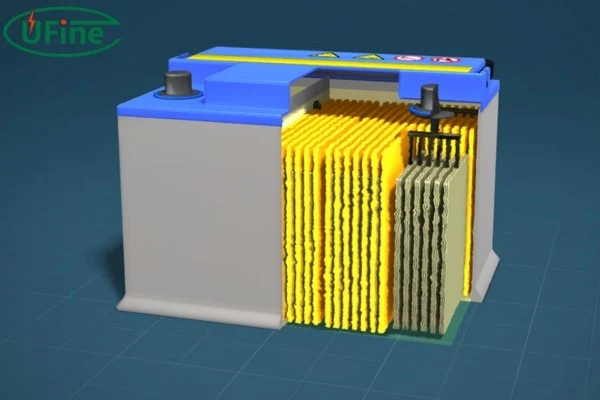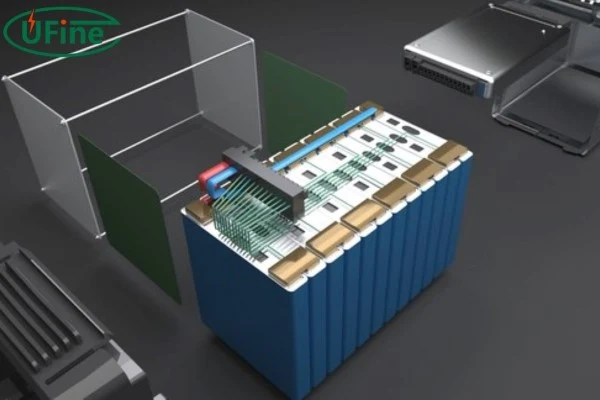When selecting a marine battery for your boat, one of the most important decisions is whether to go with a lithium-ion or lead-acid option. A lead acid battery represents the traditional batteries that are widely popular, whereas lithium batteries are advanced, improved, and highly featured batteries. However, factors contribute to making the final decision about choosing the right marine battery. This guide will clear all the doubts and queries about the different battery types to choose the right marine battery for your boat.
Part 1. Understand the types of marine batteries
When it comes to marine batteries, you will find different battery options that can confuse you. There are three main types of batteries suitable for marine needs. The first is a flooded lead acid battery, the second is an AGM (Absorbent Glass Mat), and the third is a lithium battery.
1.Lead-Acid Marine Battery
A traditional Lead-Acid or flooded battery uses lead submerged in a liquid electrolyte. It is a cheaper option for budget-conscious sailors but with some disadvantages, as the battery is bulky and needs regular maintenance. Moreover, there is also a risk of acid spills and a need for fluid top-ups.
2. AGM Marine Battery
An AGM ( Absorbent Glass Mat) is a better version of a lead-acid battery. It comes with a sealed design. So the electrolyte does not spill or need regular maintenance. This makes AGM an ideal option as a marine battery because it is cheap, maintenance-free, spill-proof, and has a longer life than old-school lead acid batteries.
3. Lithium Marine Batteries
Lithium battery is an advanced and highly featured battery. The battery uses lithium iron phosphate as a cathode for better performance. It is commonly known as a LiFePO4 battery. This can be an ideal choice as a marine battery because of its lightweight, long lifespan, high energy density, and real-time battery protection. However, the upfront cost of this marine battery is higher than that of AGM and Lead-Acid batteries.
Part 2. How to choose the right marine battery?
Now, it is time to choose the right marine battery to handle all your marine needs. Choosing the right battery always depends on many factors. One battery can not fit every boat and marine needs. Therefore, it is necessary to throw light on each aspect that contributes to making the final decision.
1.Power Requirements
Before choosing any battery, you must be aware of your marine power needs. Batteries come with different terms like Cold Cranking Amps (CCA), Cranking Amps (CA), Ampere hour (Ah) capacity, and overall battery voltage. Mostly, an average marine battery should have at least 70 to 100 Ah capacity with around 750 CCA in a 12v battery. However, some boats are bigger and need a high-power marine battery. So, checking with the boat’s owner manual about marine battery guidelines will help to determine. Secondly, if you are replacing the old marine battery with the new one, make sure the new marine battery specifications match the old one.
2. Climate Consideration
Weather conditions can influence marine battery performance. A boat sails through different regions and climates, from burning hot to freezing temperatures. This can affect the marine battery’s performance and overall lifespan. Therefore, you should choose a battery that handles such temperatures. For example, lead acid batteries can work well in high temperatures than in freezing because of liquid electrolytes. On the other hand, a lithium battery works well in freezing temperatures and faces some difficulties in high temperatures.
3. Marine Battery Usage and Storage
You should consider your usage habits and lifestyle when choosing a marine battery. If you are a seasonal sailor and do not use the boat regularly, a lithium battery is a perfect choice. It does not require maintenance, regular charge, or memory effect. On the other hand, lead acid or AGM batteries require regular maintenance. You will need to top up the fluids in lead acid and not let AGM or Lead-acid battery discharge. Otherwise, there is a risk of permanent damage to the marine battery. Similarly, keeping the battery at a dry and normal temperature guarantees a long lifespan.
4. Best Overall: Lithium Marine Battery
Lithium Maine battery is the new technology and is highly featured, which is the best battery option to choose. Lithium batteries have provided multiple features that include:
- Long lifespan of around 3,000 to 5,000 cycle life.
- Lithium batteries can be charged rapidly at a 1C to 2C rate.
- Battery Management System (BMS) protects batteries from overcharge, deep discharge, and high-low temperatures.
- Lithium battery is a maintenance-free battery
- It is 3x to 4x lighter than a lead acid battery.
- Monitor through Bluetooth and mobile app.
- LED and software-based monitoring.
Overall, lithium batteries are a good option to buy. However, the price of this battery is higher than that of lead-acid or AGM batteries. You have to pay 3 to 4 times more for a lithium marine battery. However, the upfront costs can be recovered in terms of long lifespan.
5. Runner Up: AGM Marine Battery
AGM stands as a second option for those who want a marine battery with a balance of power, lifespan, and budget-friendly. You can get some features like the lithium battery, for example, spill-proof, water-resistant, and maintenance-free. However, the battery is lacking in some areas, such as its short lifespan and keeping charge to avoid a dead battery situation. So, an AGM battery is a mid-range battery that does not cost much and can perform better than any flooded lead acid battery.
6. Budge Friendly: Lead-Acid Marine Battery
We can not set aside lead-acid batteries at all. These are the best budget-friendly battery options in the market. If you are a person who can take pains to maintain the battery from time to time, a lead acid battery is only for you. Although the battery has a lot of weight and lower life cycles, good maintenance results in a higher lifespan and better performance. Additionally, lead-acid batteries will not require one to pay a high amount at once but in the parts whenever they need a marine battery replacement.
Part 3. Finding the right marine battery
Until now, you have better understood about different types of marine batteries and their pros and cons. In the battery comparison, the lithium marine battery is the clear winner, and AGM is the runner-up. On the other hand, lead acid is a popular choice because of its cheap marine battery option. It is quite clear the newer battery technology is more battery than the older one. However, many considerations contribute to the final marine battery, as one rule can not apply to all, as everyone has unique marine requirements. Whether you go for high-quality lithium, mid-range AGM, or a budget-friendly lead-acid marine battery, there is every available option that suits your needs.
Part 4. FAQs
-
How long do marine batteries typically last?
The lifespan of a marine battery can vary significantly based on the type: Lithium-ion batteries typically last 5-10 years with proper care and usage. Lead-acid batteries and AGM usually last 2-5 years -
Can I use a car battery in my boat?
Generally, it is not recommended to use a standard automotive battery in a marine application. A marine battery is specifically designed to handle the harsh conditions and vibrations of a boat, with features like extra corrosion protection. Using a car battery may lead to premature failure. -
Can I mix battery types (e.g., lithium and lead-acid) on my boat?
Each battery type has different charging requirements and operating characteristics. This can lead to issues like undercharging or overcharging one of the batteries. It’s best to stick with a single battery chemistry across your boat’s electrical system. -
How do I properly charge my marine battery?
Every marine type has different charging parameters. For example, a lead acid or AGM battery needs to charge through multi-stage charging, including bulk, absorption, and float stages. At the same time, a lithium battery uses a specialized charger to charge each cell of the battery safely.
Related Tags:
More Articles

What Is a Disk Battery? A Simple Guide for Non-Tech Users
A disk battery is a small, round cell used in watches, remotes, and other electronic devices. It delivers steady power for compact, low-drain devices.
What Battery Powers a Space Heater?
Discover the type of battery that powers space heaters and learn how to choose the right one for efficient heating in your home or office.
What Is an LR14 Battery? Learn About This C-Size Cell
The LR14 battery, also known as a C battery, delivers steady power. Learn its specs, uses, lifespan, and how it compares to other battery types.
Watch Battery Dimensions Chart: Sizes, Voltages, and Equivalents Explained
Understanding watch battery dimensions helps you choose the right size, voltage, and equivalent model to keep your watch running safely and smoothly.
How Long Can You Rely on Battery-Powered Generators?
Discover battery generator runtime & lifespan factors. Learn how to maximize performance and choose the right power solution.






